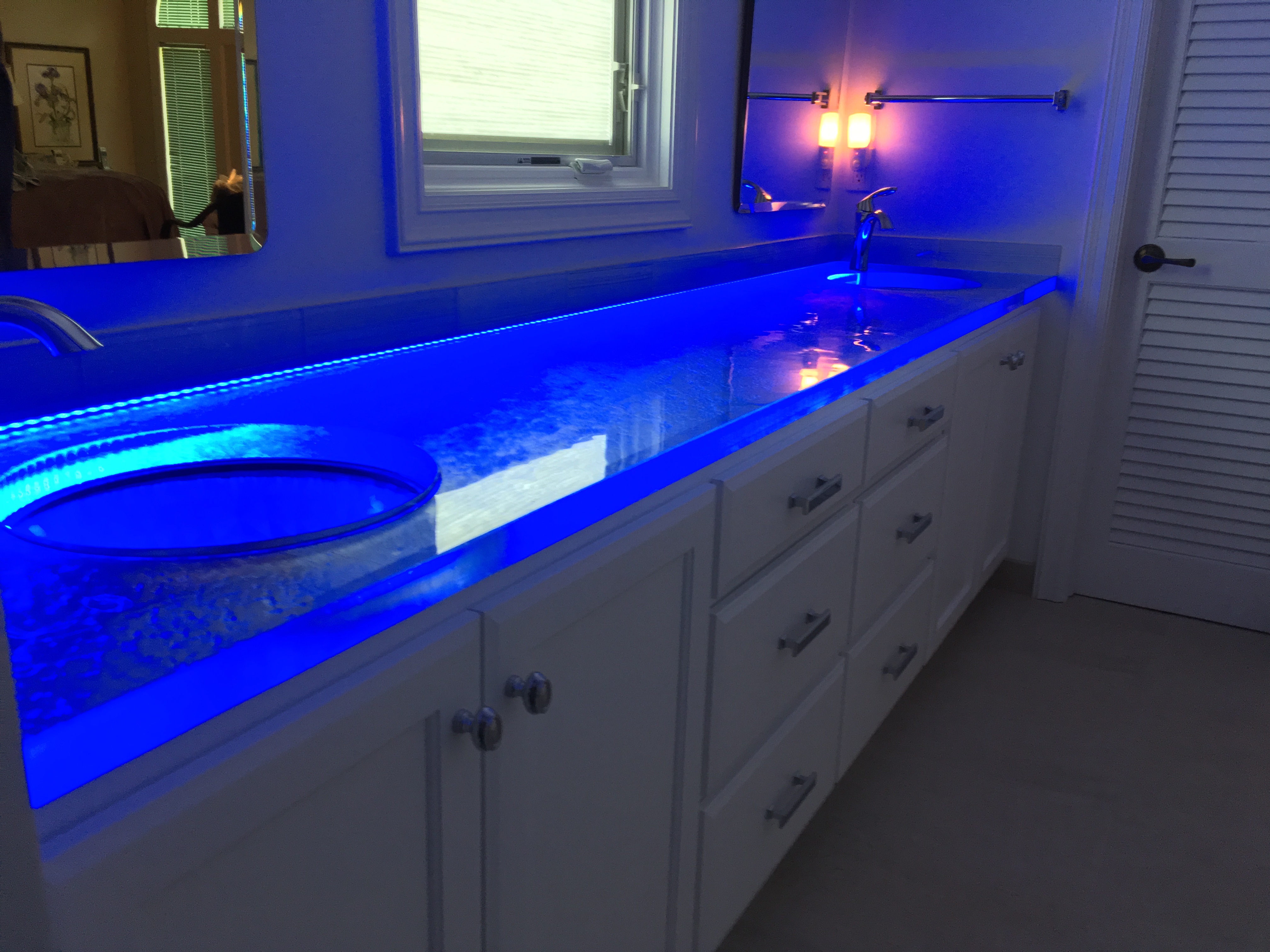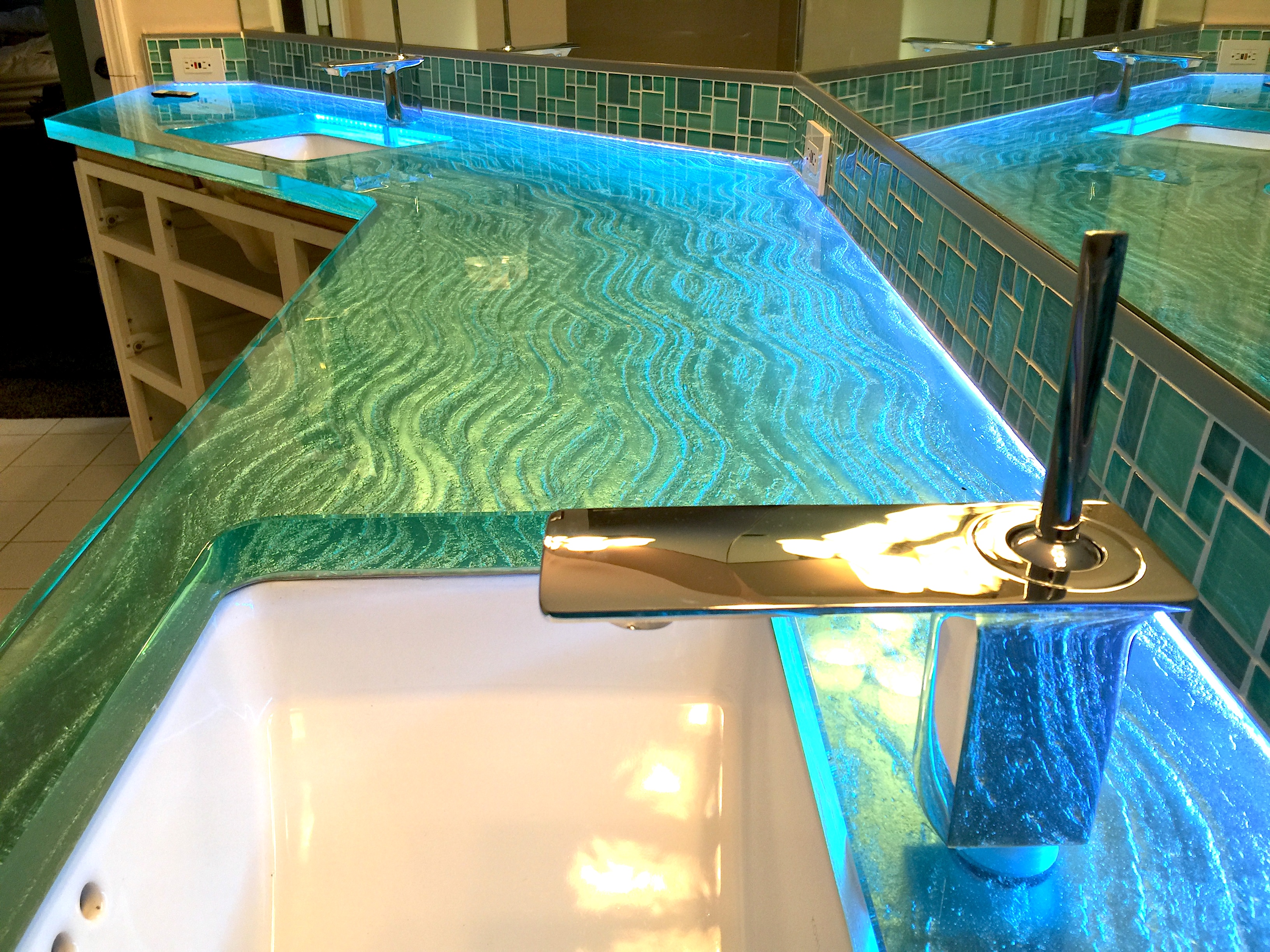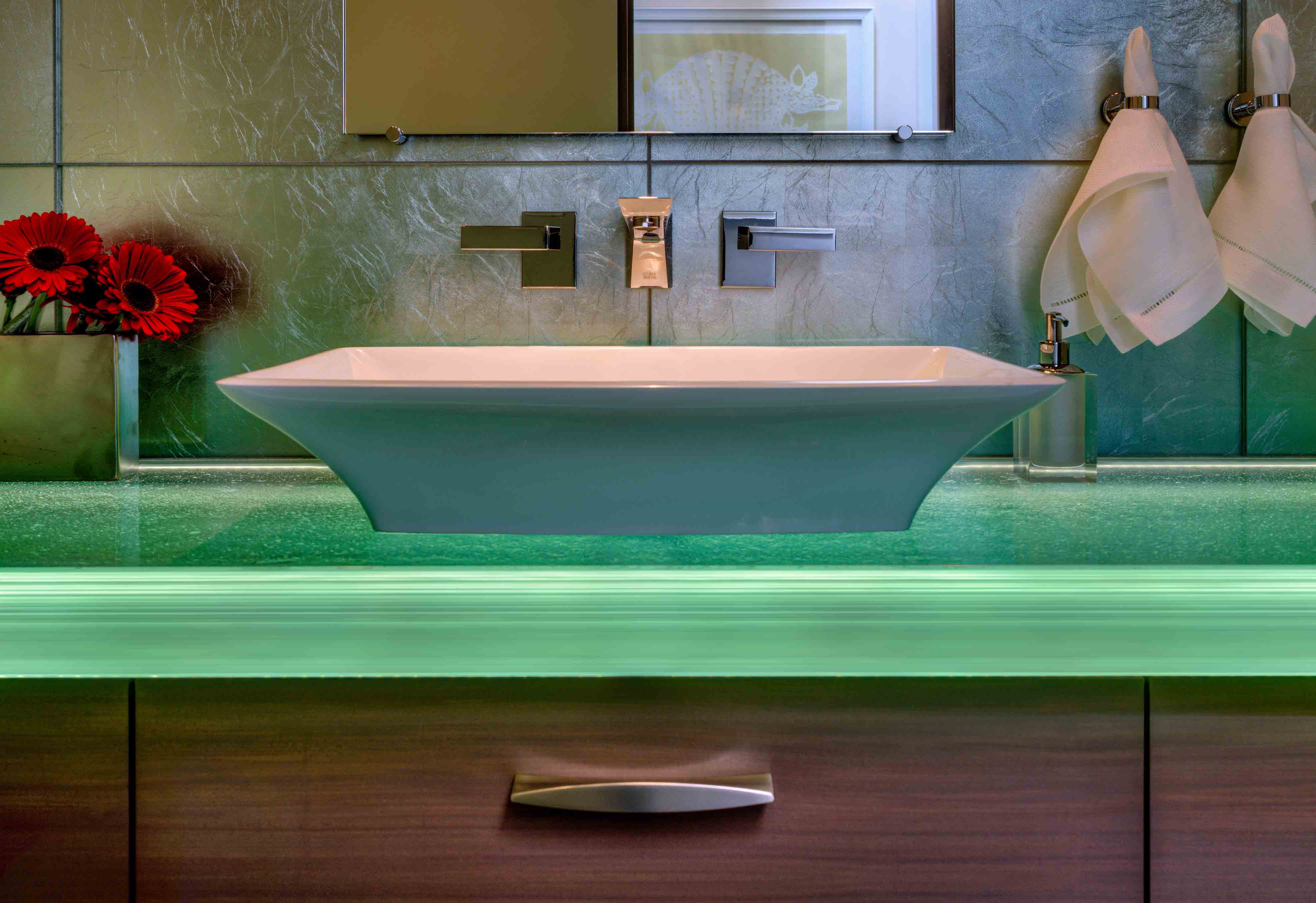A bathroom vanity is more than a sink and a surface. It is the visual anchor of a bathroom, shaping how the space feels and how it functions every single day. From the master suite to the guest powder room, the vanity sets the tone for design, hygiene, and usability. For decades, North American homes and commercial projects relied on stone, engineered quartz, or synthetic solid-surface materials for vanity tops. But in the last fifteen years, glass has emerged as a luxury material of choice, bringing together purity, artistry, and practicality.
The adoption of glass in bathrooms mirrors larger design trends. Bathrooms are no longer purely utilitarian spaces, they are personal sanctuaries in residences, brand experiences in hotels, and first impressions in restaurants or offices. In this context, materials matter. A glass vanity top communicates cleanliness, light, and exclusivity in ways that stone or composite surfaces cannot. It is non-porous, sanitary, luminous, and endlessly customizable.
This guide explores why glass vanity tops are transforming North American bathrooms, where they are most effective, what types of glass exist, how thickness affects perception, and why ThinkGlass, based in Quebec, is setting the benchmark with artisanal cast glass.

Why Choose a Glass Vanity Top?
The decision to choose glass over more traditional materials usually comes down to two sets of advantages: aesthetic and design benefits on the one hand, and practical and functional performance on the other.
On the design side, glass delivers a sophistication that works with virtually any style. It pairs as well with minimalist floating vanities as it does with ornate wood cabinetry. Its ability to transmit and reflect light makes bathrooms brighter, an especially important benefit in windowless or compact spaces. A glass vanity is not just a surface, it is a luminous design feature that interacts with its surroundings.
Glass also offers unmatched customization. Unlike marble or quartz, which are limited to their natural veining or manufactured patterns, glass can be pigmented, textured, sculpted, or illuminated. Designers can request wave-like textures, frosted edges, or LED-lit slabs that glow from within. This transforms a simple bathroom into an immersive experience.
From a functional perspective, glass excels in the very environment where a vanity top must perform: a humid, wet, product-heavy space. Glass is non-porous, meaning it does not absorb water, makeup pigments, soap residues, or hair dyes. That makes it naturally resistant to mold and bacteria. While stone often requires sealing and synthetic surfaces can discolor, glass resists staining and remains hygienic.
Key reasons homeowners and designers choose glass vanity tops include:
- Timeless sophistication that elevates bathrooms of any size.
- Optical brightness, making small or dark bathrooms feel larger.
- Unlimited design freedom with pigments, textures, and LED lighting.
- Superior hygiene due to a non-porous surface.
- Easy maintenance with standard cleaners, no sealing required.
- Eco-friendly fabrication using recyclable glass.
Where Glass Vanity Tops Work Best
Glass can technically be installed in any bathroom, but certain applications maximize its impact.
In master suites, a glass vanity top creates a luxurious focal point. Whether paired with undermount sinks or designed as an integrated basin, it brings a sense of exclusivity. Edge lighting or thick slabs add depth, while textured glass mirrors water itself, making the vanity a true centerpiece.
In powder rooms, where size is often limited, glass delivers optical expansion. Its reflective qualities make tight spaces feel larger and brighter. When paired with bold colors or integrated LED, a glass vanity in a powder room becomes a conversation starter, impressing guests and elevating what is often a neglected space.
In luxury spas and hotel bathrooms, glass vanity tops reinforce the themes of serenity and hygiene. Guests expect surfaces that feel pristine and contemporary. Glass meets those expectations while offering the durability to withstand constant cleaning cycles. Cast glass, with its thickness and resistance to chemicals, performs particularly well in hospitality contexts.
In commercial restrooms for offices, restaurants, or boutiques, glass combines aesthetics with compliance. Laminated glass is often specified in public projects, where safety codes require shard containment. Here, designers appreciate glass not only for its easy sanitization but also for the modern, upscale impression it conveys.
Typical bathroom applications include:
- Master baths requiring sculptural, durable focal points.
- Powder rooms that benefit from space-enhancing reflections.
- Spa and hotel suites seeking ambiance and sanitation.
- Commercial washrooms requiring compliance with safety codes.

Durability in Bathroom Conditions
Bathrooms challenge materials in ways kitchens do not. High humidity, frequent splashes, and exposure to cosmetics all test a surface’s resistance. Glass meets these challenges well, provided the right type is selected.
Tempered Glass
- Heat-treated to four or five times the strength of standard glass.
- Typically available in 3/8” to 3/4” thickness.
- Breaks into small, blunt fragments upon failure (ANSI Z97.1 compliant).
- Affordable, sleek, and safe, but limited in visual drama.
Laminated Glass
- Two or more sheets bonded with a PVB or EVA interlayer.
- If broken, interlayer holds shards together, improving safety.
- Thickness up to 1.5”.
- Common in public restrooms or family bathrooms.
Cast/Fused Glass (ThinkGlass Specialty)
- Kiln-cast at high heat, annealed slowly for integrity.
- Thickness up to 4”, weight up to 55 lbs/ft².
- Resistant to scratches, chipping, and UV degradation.
- Fractures into a few large pieces if damaged.
- Allows unlimited artistic textures and LED integration.
Summary of durability by type:
- Tempered: sleek and affordable, best for small-scale or minimalist bathrooms.
- Laminated: safe, suited for code-sensitive public projects.
- Cast glass: luxurious, durable, and artistic, the premium choice.
Thickness and Design Psychology in Bathrooms
The thickness of a vanity top shapes how it feels in a bathroom, where scale and light play critical roles.
Design takeaways:
- Thin slabs: modern and discreet, perfect for compact spaces.
- Medium slabs: combine mass and safety in everyday bathrooms.
- Thick slabs: dramatic and luminous, designed to impress in luxury settings.
Integration with Vanity Bases and Sinks
The choice of vanity base and sink integration defines the final aesthetic. Wood cabinets provide warmth against sleek glass. Metal frames create industrial modernism. Stone bases amplify luxury through material layering. Floating or wall-mounted units maximize the sense of openness.
Popular combinations include:
- Wood + glass: warmth meets translucence.
- Metal + glass: industrial and minimalist.
- Floating units + glass: spa-like, open, modern.
- Integrated sinks in cast glass: seamless sculptural design unique to ThinkGlass.

Hygiene and Maintenance: The Daily Advantage
Bathrooms expose vanity tops to cosmetics, soaps, toothpaste, and hair products. Porous materials absorb stains, while glass remains impervious. Its bacteriostatic surface is naturally hygienic. Maintenance is minimal: no sealing, no waxing, just simple cleaning.
Key hygiene benefits:
- Non-porous: no mold or bacteria growth.
- Resistant to stains from cosmetics and dyes.
- Easy to clean with standard products.
- NSF/ANSI Standard 51 compliance for sanitary use.
- Maintains clarity even with frequent disinfecting in hotels or spas.
Pros and Cons of Glass Vanity Tops
In short:
- Tempered = modern and minimal.
- Laminated = safe and functional.
- Cast = luxury, durability, and artistry.
Why ThinkGlass Defines Bathroom Glass Luxury
ThinkGlass, based in Quebec, is North America’s leader in cast glass, with a reputation built on bathroom innovation. Their vanity tops are sculptural, not generic, crafted with proprietary textures and custom features. Integrated LED lighting transforms surfaces into luminous art. Each piece complies with ANSI, ASTM, and CSA standards, ensuring both safety and longevity.

What sets ThinkGlass apart:
- Exclusive textures inspired by water and ice.
- Integrated LED lighting expertise.
- Bespoke fabrication for residential and hospitality projects.
- Sustainable, recyclable glass production.
- Seamless integrated sinks available in cast slabs.
Future Trends in Glass Vanity Design
Bathrooms are evolving into wellness spaces. Glass vanities are part of this future. Designers are embracing smart lighting, eco-conscious materials, and sculptural one-of-a-kind fixtures. In North America, adoption is climbing, especially in luxury developments and hospitality.
Emerging trends include:
- Smart LED controls for ambiance.
- Eco-friendly sourcing and recyclability.
- Vanities treated as art pieces.
- Increased presence in hotels and spas.
Glass vanity tops are redefining bathroom design in North America. They combine visual lightness, unmatched hygiene, and superior durability. Whether in a small powder room, a family bathroom, a luxury spa, or a hotel suite, glass elevates the space into something more than functional, it becomes experiential.
Tempered glass offers sleek affordability. Laminated glass secures safety in public use. Cast glass, led by ThinkGlass, transforms the bathroom into a showcase of luxury and artistry.
Ultimately, a ThinkGlass vanity is not just a bathroom surface. It is functional art, a luminous sculpture that withstands humidity, cleaning cycles, and daily use, while bringing light and elegance to the heart of the bathroom.
Are glass vanity tops really hygienic for bathrooms?
Indeed. Unlike some natural stones, glass is not porous, meaning it cannot absorb mold, bacteria, or water. As a result, it is easier to clean and more resilient to accumulation over time. It usually stays spotless with regular wiping with a gentle cloth and mild cleaner. Some models have surface treatments that help avoid soap residue and water stains for extra protection.
Can glass stand up to Québec’s climate and lifestyle?
Of course. Tempered glass vanity tops are made to withstand changes in humidity and temperature. This resistance to moisture and thermal shock is a significant benefit in Québec, where winters are cold and bathrooms are frequently humid. Proper installation is essential, which includes sealed joints and a strong base to sustain the glass's weight.
Which finishes lessen the appearance of water stains and fingerprints?
Despite its elegance, clear glass tends to show every mark. Finishes that are back-painted, textured, or frosted are far more tolerant and need less frequent cleaning. Additionally, matte textures give the bathroom depth and a contemporary feel while prolonging the surface's cleanliness.
Is glass a safe material for bathroom use?
Yes, provided it is manufactured and installed correctly. Tempered safety glass vanity tops are robust and, in the event of a break, break into small, blunt fragments rather than jagged pieces. Particularly in family homes, rounded or polished edges provide an additional degree of security. As with any bathroom fixture, damage over time can be avoided with the right support and sealing.




